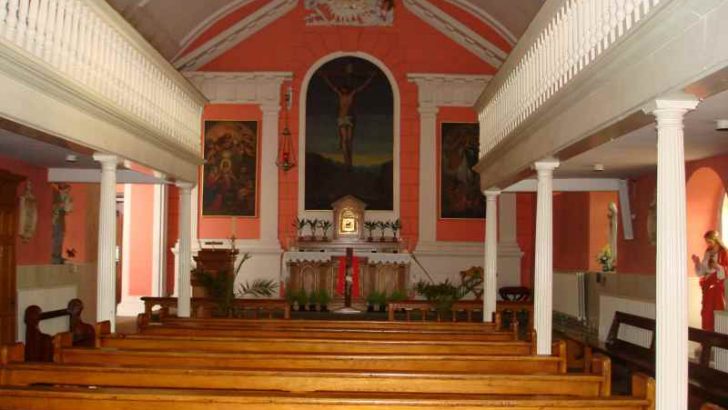The Faith Journey of the Déise People
by Michael G. Olden (Diocese of Waterford & Lismore, €40.00 + €11.00 p&p; available from The Book Centre, 25 John Roberts Square, Waterford, tel: 051-873823, website@thebookcentre.ie)
In the introduction to his new book Msgr Olden states that his aim is to provide a history of the diocese of Waterford and Lismore and of the Déise. The latter he defines as the area covered by County Waterford and South-County Tipperary and the inhabitants of that region.
The author is especially well qualified to write this book, as Msgr Olden, a priest of the Diocese of Waterford and Lismore, was born in Waterford City. He was appointed to the staff of St Patrick’s College, Maynooth in October 1966, lecturing in history. He pursued a distinguished career as an academic and administrator, while contributing to many academic publications such as Archivium Hibernicum.
On leaving Maynooth, Msgr Olden returned to the Diocese of Waterford and Lismore as Parish Priest of Tramore. Though he retired from full-time ministry some years ago, he remains an active historian.
The book, which runs to 422 pages, is lavishly illustrated, written with verve, and based on deep and sound scholarship. It is also beautifully shaped.
Missionaries
At the outset the author describes the Christian presence in Ireland prior to the mission of St Patrick. This was due to people travelling to and from Christian Britain. Later, while St Patrick evangelised in the north and west of the island, other missionaries were and had already been active elsewhere. According to tradition, St Declan of Ardmore was the apostle of the Déise.
The monastic movement flourished from 550 to 1100 AD. It was represented among the Déise by the great monastery of Lismore and its affiliates. These monasteries were centres of community, learning and divine worship.
Following the arrival of the Normans in 1169 Waterford became a more important centre than Lismore. Olden narrates the decades of division thereafter as the separate diocese of Waterford and Lismore competed for hegemony among the Déise. The tension between them continued throughout the 13th Century and into the 14th until a union of the two dioceses was completed in 1363.
Making good use of primary sources Olden provides a magisterial account of the Reformation and Counter-Reformation among the Déise. He profiles some of the leading figures of that time.
Among them was Patrick Walsh who served as bishop of Waterford and Lismore from 1551 to 1578. He had the capacity to adapt his religious beliefs to those of whoever was wearing the crown, serving under Edward VI (1551-53), Mary (1553-58) and Elizabeth (1558-78). It could be said that at best he was confused, at worst he was an archetypal careerist.
To his credit, however, he never made more than a few feeble efforts to promote the new religion, thus sparing his fellow-citizens a great deal of hardship and grief.
Luke Wadding (1588– 1657), a native of Waterford, was a champion of the Counter-Reformation. He was a Franciscan priest and a polymath with an international reputation. Resident in Rome where he enjoyed access to the Pope, he exercised considerable influence over the course of ecclesiastical affairs in Ireland.
The author’s discussion on the Penal Laws is succinct. He illustrates their cruelty and injustice by simply listing them. Their main aim, he notes, was achieved when just a tiny percentage of the land of the Déise and the rest of Ireland was left in the possession of Catholics.
Olden provides a list of the bishops of Waterford and Lismore. It includes Robert Walsh who served from1817 to 1821. It seems he was not a suitable candidate for the office by reason of his temperament. There was strong opposition to his appointment.
Then following his appointment, he soon showed his proclivity to engage in serious and long-lasting disputes. He was even at odds with Edmund Ignatius Rice and the Christian Brothers and Presentation Sisters in the diocese. Eventually the archbishop and bishops of the Ecclesiastical Province of Munster formally requested his suspension.
Olden records how the late Bishop Michael Russell was responsible for a kindly nod in the direction of the dismissed bishop when he had a plaque erected to his memory in the church of Santa Maria De La Pace in Rome, where his funeral Mass had been celebrated.
The second part of the book is a collection of brief but valuable histories of the 48 parishes in the diocese. One of the most interesting of these concerns the parish of Ring and Old Parish, known as An Rinn.
Owing to the determination of the priests and parishioners to preserve their language, culture and traditions, it became the Waterford Gaeltacht. Olden names a number of those who were mainly responsible for that happy outcome. Among them were Michael Sheehan, a Maynooth professor and later Archbishop of Sydney, Fr Victor Power, and the principal of Coláistena Rinne / Iolscoilna Mumhan, Séamus Ó hEochada, the legendary An Fear Mór.
Before concluding, Olden writes a ‘warts and all’ account of his distinguished predecessor, the renowned scholar Canon Patrick Power, whose work he acknowledges inspired him to write this magnum opus on the Déise.


 St Patrick's Church Waterford, a remarkable survival from Penal times
St Patrick's Church Waterford, a remarkable survival from Penal times 